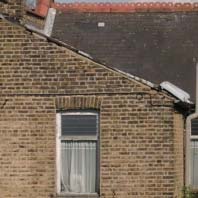Sigma DP1 Review
Review Date: April 21st 2008
Author: Mark Goldstein
Leave a comment about this Review
|
Image Quality
All of the sample images in this Review were taken using the High (2640�1760 pixels) Fine JPEG mode, which gives an average image size of around 2.5Mb.
Noise
There are 4 ISO settings available on the Sigma DP1 which you can select at any time. There is no discernible noise at the slowest settings of ISO 100 and 200, and ISO 400 also looks excellent. There is some noise at the fastest setting of ISO 800, but it's much cleaner than any other compact camera that we've reviewed. Here are some 100% crops which show the noise levels for each ISO setting:
ISO 100 (100% Crop) |
ISO 200 (100% Crop) |
 |
 |
ISO 400 (100% Crop) |
ISO 800 (100% Crop) |
 |
 |
File Quality
The Sigma DP1 has 3 different JPEG image quality settings available, with Fine being the highest quality option. Here are some 100% crops which show the quality of the various options, with the file size shown in brackets.
High
Fine (2.47Mb) (100% Crop) |
High
Normal (1.70Mb) (100% Crop) |
 |
 |
High
Basic (1.3Mb) (100% Crop) |
|
 |
|
Sharpening
Here are two 100% crops which have been Saved as Web - Quality 50 in Photoshop. The right-hand image has had some sharpening applied in Photoshop. The images are just a little soft at the default sharpening setting of 0. You can change the in-camera sharpening level to one of the 10 preset preset levels (0.2 increments on a scale of +1 to -1) if you don't like the default look.
Original
(100% Crop) |
Sharpened (100% Crop) |
 |
 |
 |
 |
Chromatic Aberrations
The Sigma DP1 handled chromatic aberrations so well during the review that I struggled to find a single example to show you. The top of the sculpture in this over-exposed shot may be exhibiting just the merest hint of purple-fringing, but then again, it could just be my eyes deceiving me!
Example
1 (100% Crop) |
 |
Macro
The Sigma DP1 doesn't offer a dedicated Macro setting. The closest distance that you can focus on a subject is 30cms away from the camera when it's set to Full Focus mode. The first image shows how close you can get to the subject (in this case a compact flash card). The second image is a 100% crop.
Macro Shot |
Macro Shot (100% Crop) |
 |
 |
Flash
The flash settings on the Sigma DP1 are On, Slow Synchro, Red-eye Reduction, Slow Synchro + Red-eye Reduction and Flash Compensation. These shots of a white coloured wall were taken at a distance of 1.5m.
Flash Off - Wide Angle (28mm) |
Auto Flash - Wide Angle (28mm) |
 |
 |
And here are some shots of yours truly. Neither the Flash On or the Red-Eye Reduction options caused any red-eye.
Flash On |
Flash On (100% Crop) |
 |
 |
Flash - Red-Eye Reduction |
Flash - Red-Eye Reduction (100% Crop) |
 |
 |
Night Shot
The Sigma DP1's maximum shutter speed is 15 seconds, which is good news if you're seriously interested in night photography. The shot below was taken using a shutter speed of 15 seconds, aperture of f/5.6 at ISO 100. I've included a 100% crop of the image to show what the quality is like.
Night Shot |
Night Shot (100% Crop) |
 |
 |
Overall Image Quality
The Sigma DP1's image quality is quite simply fantastic, by far and away the best of any compact camera that we've ever reviewed, and on a par with many DSLRs. The Sigma DP1's handled noise extremely well, with only the fastest setting of ISO 800 showing some noise and slight loss of detail. I'm a little puzzled why Sigma chose not to include an ISO 1600 setting, which on this evidence would have been pretty clean and made the DP1 more versatile. The Sigma DP1 handled chromatic aberrations so well that I struggled to find a single example from the hundreds of frames that I shot. The images were just a little soft straight out of the camera at the default sharpening setting, but you can increase the level in-camera, or use Adobe Photoshop later. The night photograph was very good, with the maximum shutter speed of 15 seconds allowing you to capture enough light for the majority of after-dark situations. The built-in flash worked quite well indoors, with no red-eye, adequate range and fairly good overall exposure. Macro performance was the only fly in the ointment, allowing you to focus as close as 30cms away from the subject, which means that you'll need to buy the DP1 lens hood and then fit a third-party close-up macro filter if you want to get really close to your subject.
|
![]() PhotographyBLOG
is a member of the DIWA
organisation. Our test results for the Sigma DP1 have been submitted to DIWA
for comparison with test results for different samples of
the same camera model supplied by other DIWA
member sites.
PhotographyBLOG
is a member of the DIWA
organisation. Our test results for the Sigma DP1 have been submitted to DIWA
for comparison with test results for different samples of
the same camera model supplied by other DIWA
member sites.
